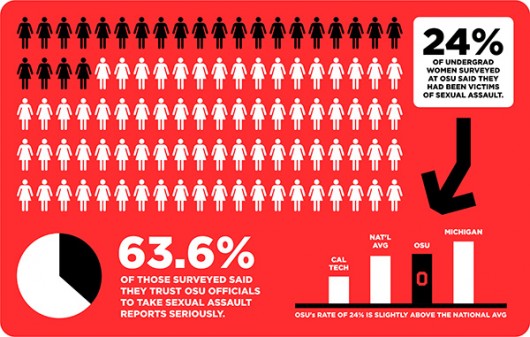
Ohio State statistics from the Association of American Universities’ national campus climate survey on sexual misconduct and relationship violence. Credit: Denny Check / Design Editor
Last week the Ohio State community received the report on the Campus Climate Survey on Sexual Assault and Sexual Misconduct. Among other things, this report states that by their senior year, more than one in four OSU women undergraduates experienced at least one sexual assault — defined as “nonconsensual penetration or sexual touching by force or by incapacitation.” This and other equally worrying findings, such as the high prevalence of sexual victimization of nonheterosexuals, was the result of a survey of 11,154 OSU students conducted by the Association of American Universities.
The OSU numbers fall in line with the numbers at other universities that were similarly polled. When Joe Biden appeared on campus on Sept. 17 to speak on behalf of the It’s On Us campaign, he cited this national trend in his passionate plea to make our campus safe for women and sexual minorities, to address sexual assault as a serious crime, get help for survivors, and initiate prevention programs. During Biden’s visit, OSU President Michael Drake also uncovered the school’s new plan to address sexual assault, which will include sexual violence awareness training for all OSU students.
Let’s connect the dots on this issue: A month ago, OSU made the news when, during move-in week, a residence near campus hung hand-painted signs boasting “Daughter Daycare” and “Dads, we’ll take it from here.” The snarkiness of the daddy message is that in a man’s world, women are handed from fathers to other men, and daughters are being delivered to campus where these other men are waiting to get their hands on them. The young men responsible for the banners, apparently OSU seniors, argued that “it was all a good joke, nothing personal to anybody” and “we just do this for fun, man.”
The statistics reported by OSU students make it hard to believe women and sexual minorities are having as much fun. Twenty-point-six percent of female undergraduate students reported incidents of sexual acts initiated in spite of refusal of permission, ignoring cues to stop or slow down and failing to obtain consent. Forty-eight-point-six percent of all students indicate they have been victims of sexual harassment with female undergraduate students reporting this most often (60.8 percent) followed by female graduate students (45 percent) and male undergraduate students (41.2 percent). A larger proportion of LGBTQ students overall indicated they have been the victims of sexual harassment and assault than have heterosexuals. The majority of reported offenders in all cases (90.5 percent) were other students.
We in the Department of Women’s, Gender and Sexuality Studies at OSU would like to make a public call to the campus community to step up current efforts to raise awareness about rape and sexual violence, with special attention to the vulnerability of women and nonheterosexuals.
- The OSU survey, in conjunction with the move-in week incident, lays out the realities of “rape culture” — a climate in which sexual assault is widespread but isn’t taken seriously and is laughed off as part of the social scene. Women’s bodies and the bodies of LGBTQ persons are highly at risk in this culture. The It’s On Us campaign stresses the urgency of awareness and responsibility, and the move-in incident is a good example of what that entails: We need to call out behavior and language that isn’t just offensive but that actually contributes to sexual violence by generating a climate in which it’s shrugged off.
- Although rape education “is on us,” it’s also on OSU as an institution to address these problems with more attention than we have seen in the past. Joseph E. Steinmetz, executive vice president and provost, is heading a task force to respond to these findings, and we hope to see this group pull together campus resources from the medical center faculty, counseling services, wellness services and the police in order to work on training, prevention and care for survivors.
- The recent OSU update of the Sexual Misconduct, Sexual Harassment and Relationship Violence policy urgently needs to be revised to address the serious safety threats to LGBTQ students and staff. The policy does not explain how the different types of misconduct, harassment and violence might apply to and be experienced by persons of different genders and gender/sexual identities. Implicit in the language is an emphasis on types of violations most common among heterosexuals. While the policy does not explicitly exclude nonheterosexuals and may cover their experiences, it would do so only if they fell within the context of the “normalized” forms of harassment, misconduct and partner violence more common to people in relationships or trying to start relationships. That is, nowhere in this document on “relationship violence” is any reference to violence, harassment or misconduct whose victims are sexual minorities and trans people. This is a shocking omission given other university policies that support diversity and make unacceptable all forms of discrimination against these groups.
We at WGSS fervently agree that “it’s on us,” all of us, to work against sexual violence, and we strongly believe that it’s on OSU as well to step up and make this happen.
The Faculty of the Department of Women’s, Gender and Sexuality Studies [email protected]


